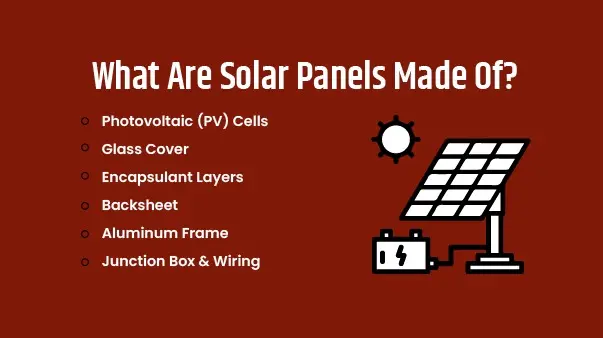How are Solar Panels Made?
There has been a shift in the consumption of energy resources over the years. Solar energy is taking the place of conventional energy resources and for good! The sun’s energy is being used to produce electricity and assist in fulfilling the energy requirements. Solar panels are a cutting-edge technology that has opened doors to a solution for the energy crisis. This is the reason why it becomes necessary to know everything about solar power systems. Solar energy is probably the best thing to ever exist, it's effective, efficient and not harmful to our environment. Solar power systems make the best use of the sun's energy possible. As we already know, solar panels are the visible and crucial part of this whole setup.
So, what are the benefits of a solar rooftop system? And most importantly, why are solar panels so important for the solar power system? How do solar panels work? If these questions find a home in your mind, you are in the right place. Solar panels are undoubtedly good, but one must know how they are made and designed. This blog will help you find it all out!
What is a Solar Panel?
Solar Panels are like the lifelines that basically run the whole solar system. Before proceeding to the hows and whys of the process through which these solar panels are created, let's look at what they are.
In very simple terms, solar panels are one of the parts of the system that convert sunlight to electricity. The panels can then be used to power appliances and even electricity grids for our use. Generally, a single solar panel is not able to generate enough usable power. Hence, we often find them arranged together in groups to produce effective electricity.
- Solar panels, when in contact with sunlight, begin their energy production. The Photovoltaic Cells in these panels start generating free electrons, creating an electricity current.
- As households and businesses use alternating current electricity, the Direct Current (DC) is converted to Alternating Current (AC).
- The energy produced by them is then stored in batteries for later use. The solar storage helps in times of need (such as power outages or bad weather conditions).
As an efficient and clean solution, they also help to protect the environment from greenhouse gas emissions.
Application of Solar Panel Systems:
- Residential areas
- Commercial buildings
- Solar Farms
- Agricultural uses
- Remote locations
- Solar pumps for rural areas
What Are Solar Panels Made Of?

You might have wondered how these panels are actually devised. What are the best solar panels in India made of?
- Solar cells are typically made of silicon. It is the key component for creating electric energy. There are two forms of it: Monocrystalline silicon and polycrystalline silicon.
- Crystalline silicon is used for most of the solar cells that we see around.
- A tempered layer of glass is used to cover and protect the silicon cells.
- Apart from this, the connecting wires are often made from copper.
- Ethylene-vinyl acetate (EVA) surrounds and encapsulates the photovoltaic cells to protect them.
- Plastic, metal and glass are other crucial things needed to produce them.
How are Solar Panels Made?
Having been equipped with all the major pre-knowledge that one has to have, we are now ready to dive into how these panels are created.
Step 1. The first step involves extracting silicon. The extracted silicon is purified through a chemical process.
Step 2. The purified silicon is melted at very high temperatures to allow their formation to ingots. The ingots are cylindrical in shape, and the structure allows for slicing into thin sheets.
During this process, however, the molten silicon is again cooled down after adding a pinch of phosphorus or boron to give it semiconductor properties.
Step 3. The silicon ingots are sliced into thin wafers. These wafers are used as building blocks of solar cells. The wafer is similar to a sort of thin paper sheet.
Step 4. Once these sheets have been obtained, they are coated for anti-reflection. This is done primarily to avoid the reflection of solar rays instead of their entrapment. Thin lines are cut for the flow of current in these cells.
Step 5. These cells are either p-type or n-type. Positively charged (p-type) differ from one that's negatively charged (n-type) in their composition of base and top layers.
Step 6. Many such solar cells are brought together to form one solar panel. On average, one solar panel uses around 60 to 72 cells to function properly. A single cell produces very little energy.
Step 7. A backsheet becomes important to cover and provide security to the back side of solar panels. It presents unwanted wear and tear, reducing the amount to be spent on maintenance later on.
Step 8. The next action is the installation of a glass sheet to the front or the absorptive side of solar panels. Glass provides a transparent medium that protects the fragile solar cells. This does not hinder the access of sunlight to the solar panel.
Step 9. A metal frame acts as a strengthening device. It provides a frame to the whole organisation of solar cells and other components. Going around the silicon, it also helps in fusing all layers.
Step 10. The junction box is installed in the end to ensure the protection of all the wiring done in the solar panels. These panels can subsequently be connected to an inverter or different types of solar batteries.
With this, our Solar panels get ready to be shipped and installed to different places for a variety of potential uses they can offer!
Conclusion
At KLK Ventures, you get the guarantee of supreme quality and the best of technology, offering highly efficient solar panels. There is a lot of choice available for you and according to your needs, we will help customize the best arrangement possible. Be it for household, industrial, or commercial purposes, KLK Ventures should be your one-stop solution for top-notch solar services!
With a merge of expertise and science, our solar panels can serve all kinds of needs and purposes. We provide installation of Grid-tied, off-grid and hybrid solar systems, and annual maintenance, without costing you a fortune. Plus, solar energy itself is known as an investment that is highly economically and environmentally feasible in the long run! Be kind and empathetic to both your pockets and nature by bringing the gift of solar energy to your homes. You won't regret joining hands with KLK Ventures when you decide to venture on the part of sustainability.
